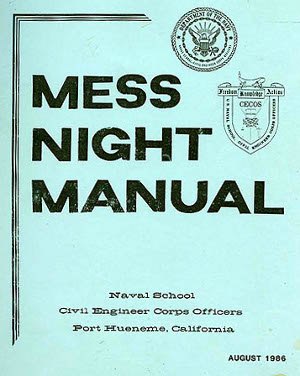Topic: Tradition

Mess Night Manual
 From the US Navy Department Library comes the 1986 edition of the Mess Night Manual published by the Naval School, Civil Engineer Corps Officers, Port Huenema, California, dated August 1986.
From the US Navy Department Library comes the 1986 edition of the Mess Night Manual published by the Naval School, Civil Engineer Corps Officers, Port Huenema, California, dated August 1986.
MESS NIGHT ORIGINS
A "Mess Night" is a scheduled evening when mess members and their guests gather in the mess for dinner. A formal Mess Night is referred to as a "Dining-In." Normally only officers of the mess and command guests are included. When spouses and other personal guests are invited, the occasion is called a "Dining-Out." Throughout this publication, the term "Mess Night" will be used as synonymous with both "Dining-In" and "Dining-Out." "Dinings-In" and "Dinings-Out" are conducted in the same format. The only difference is in the attendees.
A Mess Night is more than an officer's dinner party. It is a military formation, as old and as rich in tradition as the quarterdeck or the mounting of the guard, and as essential to a close-knit, smooth-performing unit as are drills, inspections and military ceremonies. Throughout the messes of the world, military men meet to honor their regiments, ships, standards, battles and dead. It is significant to note that irrespective of nationality, these mess formations vary in form only so much as do the traditions of the military organizations. It cannot be too strongly emphasized that mess night is not a party in any sense; it is very similar to honors, for its purpose is to solemnly pay tribute to all of those intangibles for and by which the military unit stands.
The Mess Night format is derived through tradition from a number of sources, particularly the Vikings and the British Navy. Meticulous attention should be given to the traditional aspects of this format.
The "Dining-In" had its inception in the earliest military victory celebrations. In the opening centuries of the Christian Era, it took its first step toward a stylized format in the revels of the Viking Clans on the occasion of their return from successful raids and forays against distant shores. These celebrations saw all male clan members present with the exception of the watch. The leader took his place at the head of the board with all others to his right or left in descending order of rank. Those of the clan who did not participate in the raid were seated below the salt, and did not participate in the disposition of the spoils. Warriors who had conducted themselves with valor or distinction were "guests" for the evening. They were seated closer to the leader than their rank normally entitled them. These "guests" customarily received a bonus from the share of the leader for their deeds.
The celebrations of the Vikings were great feasts where vast quantities of food and drink were served. Down through the millennium since the heyday of the Norsemen, the practice of recognizing and perpetuating the anniversaries of significant battles and feats of outstanding heroes by formal ceremony became generally adopted as a natural outgrowth of the special camaraderie of the military.
Like so many of our service traditions, the term "Mess Night" and the format used in the U.S. Navy today was derived from the British Navy. Although the tradition is very old in England, it is not exclusively military. Tradition has it that the custom began in the monasteries, was adopted by the early universities, and later spread to military units when the officers' mess was established. At one time, the formal dining procedure was observed nightly in the British military messes. This nightly formality and elegance was abandoned by the United States Navy when alcoholic beverages were abolished aboard ship by General Order 99. However, Mess Nights are still observed on special occasions such as an anniversary, a commissioning or decommissioning, the visit of a senior officer, or simply to enjoy good company.

The manual is divided into several sections for the convenience of the reader.
- Section I, Mess Night Origins, presents a capsule summary of the meaning of Mess Night and the background of the traditions which are observed at Mess Nights.
- Section II, Mess Night Format, traces the various events which occur in a Mess Night.
- Section III, Toasts, is a summary of the etiquette of toasting as practiced at Mess Nights.
- Section IV, Arrangements, is intended primarily for those individuals who are responsible for planning and organizing a Mess Night, but may be of general interest to all officers.
The manual also contains several appendices which may be of assistance in planning a Mess Night.
- Appendix A is a Summary of the Rules of Etiquette for Mess Night Attendees, which should be made available to all officers and guests attending the occasion.
- Appendix B, Recommended Schedule for Mess Night Preparations, lists the "countdown" or actions which should be taken in preparing for a Mess Night.
- Appendix C, Form of Toasts for Heads of State, may prove useful when foreign guests attend a Mess Night.
- Appendix D, Sample Mess Night Script is included to serve as a guide in preparing the Mess Night Script.
- Appendix E contains a Sample Mess Night Souvenir Menu.

